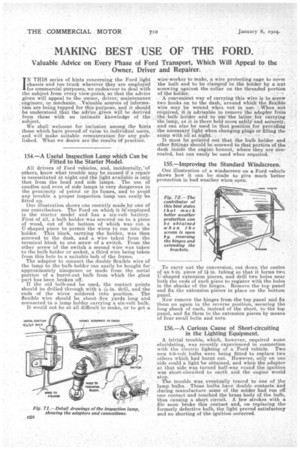MAKING BEST USE OF THE FORD.
Page 12

If you've noticed an error in this article please click here to report it so we can fix it.
IN THIS series of hints concerning the Ford light, chassis and ton truck wherever they are employed for commercial purposes, we endeavour to deal with the subject from every view-point, so that the advice given will appeal to the owner, driver, maintenance . engineer, or mechanic. Valuable sources of information are being tapped for this purpose, and it should be understood that the advice given will be derived
• from those •with an intimate knowledge of the , . subject. . ,
We shall welcome for inclusion among the hints those which have proved of -Value to individual users, and will make suitable remuneration for any published. What we desire are the results of practice.
154.—A Useful Inspection Lamp which Can be Fitted to the Starter Model.
All drivers of Ford vehicles, and, incidentally, 'of others, know what trouble may be mused if a repair is necessitated at night end the light available is only that from the head and side lamps. The use of candles and even of side lamps is very dangerous in the proximity of petrol or its fumes, and to avoid any trouble a proper inspection lamp can easily 'be fitted up.
Our illustration shows one recently made by one of our contributors. The Ford on which it Wernployed is the starter model and has a six-volt battery. First of all, a bulb holder was screwed on to a piece of wood, out of the bottom of which was cut a U-shaped piece to permit the wires to run into the holder. This block, carrying the holder, was then screwed to the dash, and a wire taken from the terminal block to one screw of a switch. From the other screw of the switch a second wire was taken to the bulb holder or socket, a third wire being taken from this hole to a suitable bolt of the frame.
The adaptor to connect the double flexible wire of the lamp to the bulb holder can easily be bought for approximately ninepence or made from the metal portion of a burnt-out bulb from whieh the glass part has been broken off.
If the old bulb-end be used, the contact points should be drilled through with a A-in. drill, and the ends of the wires soldered into position. The flexible wire should be about five yards long and connected to a. lamp holcle,r carrying a six-volt bulb.
It would not be at all difficult to make, or to get a , wire-Worker to make, a wire protecting cage to cavei the bulb and to be clamped to the holder bY a nut screwing against the collar on the threaded portion of the holder.
A convenient way of carrying this wire is to screw two hooks on to the dash, around which the flexible wire may be wound whea not in use When not required, it is advisable to remove' the adapter from the bulb holder and to use the latter for carrying the Duni), as it is there held more safely and securely; and can also be Used in that position for providing the necessary light when changing plugs Or filling the sump With oil at night. .
It Must be pointed out that the bulb holder and other fittings should be screwed to that portion of the dash inside the engine bonnet, where they are concealed, but can easily be used when required.
155.—Improving the Standard Windscreen.
Our illustration of a windscreen on a Ford -vehicle shows how it can be made to give much better protection in bad weather when open.
... . . ...................
To carry out the conversion, cut down the centre of an 8-in, piece of tubing so that it forms two U-shaped extension pieces, and drill two holes near both the ends of each piece to register with the holes in the shanks of the hinges. Remove the top panel and fix the extension pieces in place on the bottom panel.
Now remove the hinges from the top panel and fix them on again in the reverse position, securing the long shank of each, instead of the short, to the top panel, and fix them to the extension pieces by means of four small bolts and nuts.
156.—A Curious Cause of Short-circuiting in the Lighting Equipment.
A trivial trouble, which, however, required some elucidating, was recently experienc,ed in connection with the electric lighting of a Ford vehicle. Two new 8-9-volt bulbs were being fitted to replace two others which had burnt out. However, only on one side could a light be obtained, and when the adapter at that side was turned half-way round the ignition was short-circuited to earth and the engine would
stop. •
• The trouble was. eventually traced to one of the lamp bulbs. These bulbs have double contacts and during manufacture some of the solder had run off one contact and touched the brass body of the bulb, thus causing a short circuit. A few strokes with a file soon broke this contact and, on replacing the formerly defective bulb, the light proved satisfactory and no shorting of the ignition occurred.




























